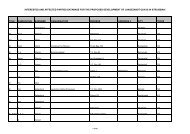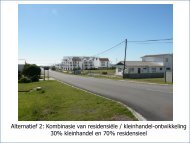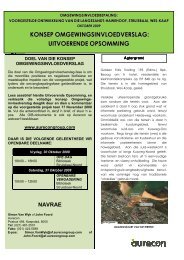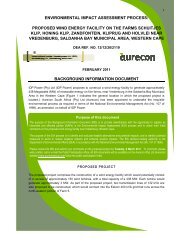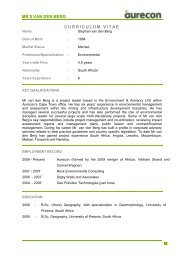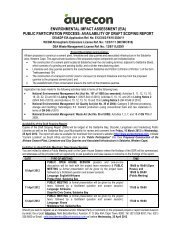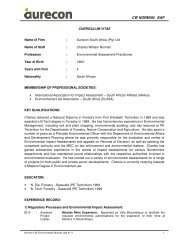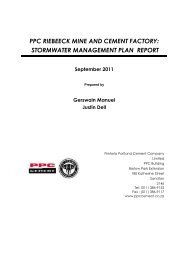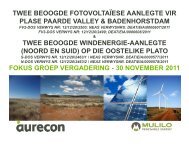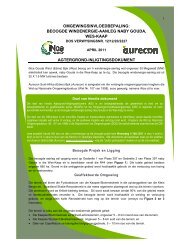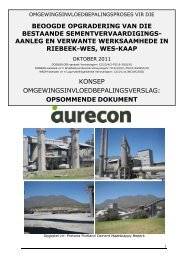Final EIAR - Aurecon AME Environmental | Environmental Projects
Final EIAR - Aurecon AME Environmental | Environmental Projects
Final EIAR - Aurecon AME Environmental | Environmental Projects
Create successful ePaper yourself
Turn your PDF publications into a flip-book with our unique Google optimized e-Paper software.
Proposed Wind and Solar (Photovoltaic) Energy Facilities on Kangnas Farm near Springbok in the Northern Cape: <strong>Final</strong> EIR 23<br />
biomass-based cogeneration, as well as technologies with larger-scale application, such as<br />
solar water heating, wind and small-scale hydro.<br />
Addressing environmental impacts and the overarching threats and commitments to climate<br />
change, the White Paper provides the platform for further policy and strategy development in<br />
terms of renewable energy in the South African energy environment.<br />
2.1.4 National Energy Act (No. 34 of 2008) and Electricity Regulation Act (No. 4<br />
of 2006)<br />
South Africa has two acts that direct the planning and development of the country’s electricity<br />
sector:<br />
i. The National Energy Act (No. 34 of 2008); and<br />
ii. The Electricity Regulation Act (ERA) (No. 4 of 2006).<br />
In May 2011, the Department of Energy (DoE) gazetted the Electricity Regulations on New<br />
Generation Capacity under the ERA. The New Generation Regulations establish rules and<br />
guidelines that are applicable to the undertaking of an IPP Bid Programme and the procurement<br />
of an IPP for new generation capacity. They also facilitate the fair treatment and nondiscrimination<br />
between IPPs and the buyer of the energy 6 .<br />
In terms of the New Generation Regulations, the Integrated Resource Plan (IRP) (see<br />
Section 2.1.7) has been developed by the DoE and sets out the new generation capacity<br />
requirement per technology, taking energy efficiency and the demand-side management<br />
projects into account. This required, new generation capacity must be met through the<br />
technologies and projects listed in the IRP and all IPP procurement programmes will be<br />
undertaken in accordance with the specified capacities and technologies listed in the IRP 7 .<br />
2.1.5 IPP Procurement Process<br />
South Africa aims to procure 3 725 MW capacity of renewable energy by 2016 (the first round of<br />
procurement). This 3 725 MW is broadly in accordance with the capacity allocated to renewable<br />
energy generation in IRP2010.<br />
On 3 August 2011, DoE formally invited interested parties with relevant experience to submit<br />
proposals for the finance, operation and maintenance of renewable energy generation facilities<br />
adopting any of onshore wind, solar thermal, solar photovoltaic, biomass, biogas, landfill gas or<br />
small hydro technologies for the purpose of entering, inter alia, an Implementation Agreement<br />
with DoE and a Power Purchase Agreement with a buyer (Eskom) 8 in terms of the ERA. This<br />
Request for Qualification and Proposals (RFP) for new generation capacity was issued under<br />
the IPP Procurement Programme. The IPP Procurement Programme has been designed to<br />
6 http://www.eskom.co.za/c/73/ipp-processes/ (accessed 29/10/11)<br />
7 http://www.eskom.co.za/c/73/ipp-processes/ (accessed 29/10/11)<br />
8 http://www.ipp-renewables.co.za/wp-content/uploads/2011/08/Tender_Notice.png (accessed 30/10/11)<br />
© <strong>Aurecon</strong> (2012) No unauthorised reproduction, copy<br />
or adaptation, in whole or in part, may be made.<br />
P:\<strong>Projects</strong>\108495 Kangnas WEF & PV EIA's\3 Project Delivery\4 Reports\FEIR\FEIR 210213 <strong>Final</strong>.doc


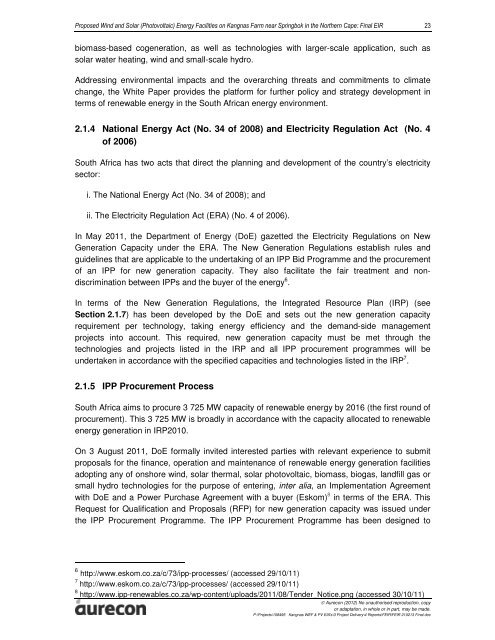
![CRR IV FEIR ~ 26042010 [FINAL].pdf - Environmental Projects](https://img.yumpu.com/21973020/1/184x260/crr-iv-feir-26042010-finalpdf-environmental-projects.jpg?quality=85)
